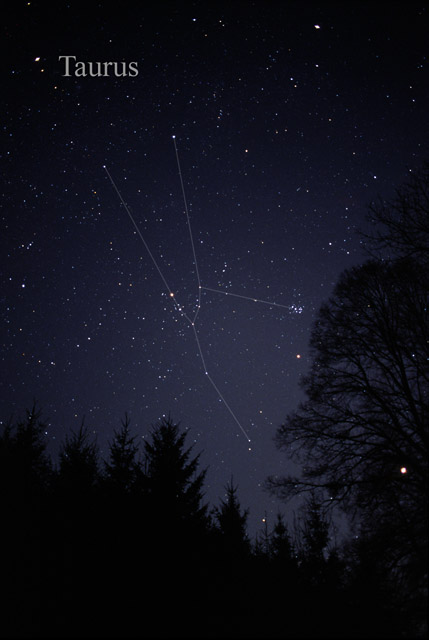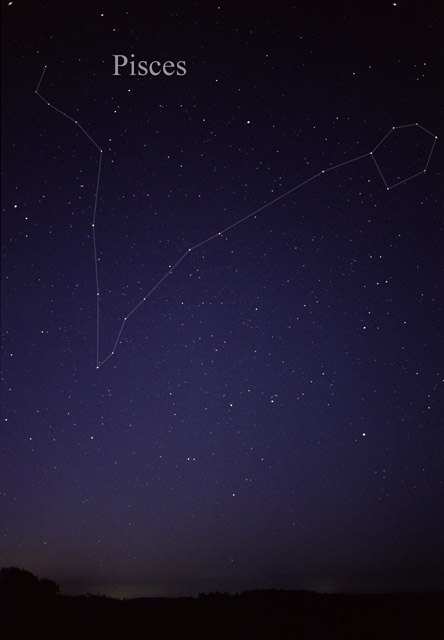|
Celestial Equator
The celestial equator is the great circle of the imaginary celestial sphere on the same plane as the equator of Earth. This plane of reference bases the equatorial coordinate system. In other words, the celestial equator is an abstract projection of the terrestrial equator into outer space. Due to Earth's axial tilt, the celestial equator is currently inclined by about 23.44° with respect to the ecliptic (the plane of Earth's orbit), but has varied from about 22.0° to 24.5° over the past 5 million years due to perturbation from other planets. An observer standing on Earth's equator visualizes the celestial equator as a semicircle passing through the zenith, the point directly overhead. As the observer moves north (or south), the celestial equator tilts towards the opposite horizon. The celestial equator is defined to be infinitely distant (since it is on the celestial sphere); thus, the ends of the semicircle always intersect the horizon due east and due west, regardl ... [...More Info...] [...Related Items...] OR: [Wikipedia] [Google] [Baidu] |
Horizon
The horizon is the apparent line that separates the surface of a celestial body from its sky when viewed from the perspective of an observer on or near the surface of the relevant body. This line divides all viewing directions based on whether it intersects the relevant body's surface or not. The ''true horizon'' is a theoretical line, which can only be observed to any degree of accuracy when it lies along a relatively smooth surface such as that of Earth's oceans. At many locations, this line is obscured by terrain, and on Earth it can also be obscured by life forms such as trees and/or human constructs such as buildings. The resulting intersection of such obstructions with the sky is called the ''visible horizon''. On Earth, when looking at a sea from a shore, the part of the sea closest to the horizon is called the offing. Pronounced, "Hor-I-zon". The true horizon surrounds the observer and it is typically assumed to be a circle, drawn on the surface of a perfectly spheri ... [...More Info...] [...Related Items...] OR: [Wikipedia] [Google] [Baidu] |
Orion's Belt
Orion's Belt or the Belt of Orion, also known as the Three Kings or Three Sisters, is an asterism in the constellation Orion. It consists of the three bright stars Alnitak, Alnilam and Mintaka. Looking for Orion's Belt is the easiest way to locate Orion in the night sky. The stars are more or less evenly spaced in a nearly straight line, and so can be visualized as the belt of the eponymous hunter's clothing. They are best viewed in the early night sky during the Northern Winter/Southern Summer, in particular, the month of January at around 9:00 pm. Component stars The names of the three stars come from Arabic. () means " string of pearls" or is related to the word ("sapphire"); spelling variants include and , with all three evidently being mistakes in transliteration or copy errors. Alnitak Alnitak (ζ Orionis) is a triple star system at the eastern end of Orion's belt and is 1,260 light-years from the Earth. Alnitak B is a 4th-magnitude B-type star which orbits Al ... [...More Info...] [...Related Items...] OR: [Wikipedia] [Google] [Baidu] |
Orion (constellation)
Orion is a prominent constellation located on the celestial equator and visible throughout the world. It is one of the most conspicuous and recognizable constellations in the night sky. It is named after Orion, a hunter in Greek mythology. Its brightest stars are the blue-white Rigel (Beta Orionis) and the red Betelgeuse (Alpha Orionis). Characteristics Orion is bordered by Taurus to the northwest, Eridanus to the southwest, Lepus to the south, Monoceros to the east, and Gemini to the northeast. Covering 594 square degrees, Orion ranks twenty-sixth of the 88 constellations in size. The constellation boundaries, as set by Belgian astronomer Eugène Delporte in 1930, are defined by a polygon of 26 sides. In the equatorial coordinate system, the right ascension coordinates of these borders lie between and , while the declination coordinates are between and . The constellation's three-letter abbreviation, as adopted by the International Astronomical Union in 1922, is "Ori ... [...More Info...] [...Related Items...] OR: [Wikipedia] [Google] [Baidu] |
Eridanus (constellation)
Eridanus () is a constellation in the southern celestial hemisphere. It is represented as a river. One of the 48 constellations listed by the 2nd century astronomer Ptolemy, it remains one of the 88 modern constellations. It is the sixth largest of the modern constellations, and the one that extends farthest in the sky from north to south. The same name was later taken as a Latin name for the real Po River and also for the name of a minor river in Athens. Features Stars At its southern end is the magnitude 0.5 star Achernar, designated Alpha Eridani. It is a blue-white hued main sequence star 144 light-years from Earth, whose traditional name means "the river's end". Achernar is a very peculiar star because it is one of the flattest stars known. Observations indicate that its radius is about 50% larger at the equator than at the poles. This distortion occurs because the star is spinning extremely rapidly. There are several other noteworthy stars in Eridanus, includin ... [...More Info...] [...Related Items...] OR: [Wikipedia] [Google] [Baidu] |
Taurus (constellation)
Taurus (Latin for "the Bull") is one of the constellations of the zodiac and is located in the northern celestial hemisphere. Taurus is a large and prominent constellation in the Northern Hemisphere's winter sky. It is one of the oldest constellations, dating back to the Early Bronze Age at least, when it marked the location of the Sun during the spring equinox. Its importance to the agricultural calendar influenced various bull figures in the mythologies of Ancient Sumer, Akkad, Assyria, Babylon, Egypt, Greece, and Rome. Its old astronomical symbol is (♉︎), which resembles a bull's head. A number of features exist that are of interest to astronomers. Taurus hosts two of the nearest open clusters to Earth, the Pleiades and the Hyades, both of which are visible to the naked eye. At first magnitude, the red giant Aldebaran is the brightest star in the constellation. In the northeast part of Taurus is Messier 1, more commonly known as the Crab Nebula, a supernova r ... [...More Info...] [...Related Items...] OR: [Wikipedia] [Google] [Baidu] |
Cetus
Cetus () is a constellation, sometimes called 'the whale' in English. The Cetus was a sea monster in Greek mythology which both Perseus and Heracles needed to slay. Cetus is in the region of the sky that contains other water-related constellations: Aquarius, Pisces and Eridanus. Features Ecliptic Cetus is not among the 12 true zodiac constellations in the J2000 epoch, nor classical 12-part zodiac. The ecliptic passes less than 0.25° from one of its corners. Thus the moon and planets will enter Cetus (occulting any stars as a foreground object) in 50% of their successive orbits briefly and the southern part of the sun appears in Cetus for about one day each year. Many asteroids in belts have longer phases occulting the north-western part of Cetus, those with a slightly greater inclination to the ecliptic than the moon and planets. As seen from Mars, the ecliptic (apparent plane of the sun and also the average plane of the planets which is almost the same) passes in ... [...More Info...] [...Related Items...] OR: [Wikipedia] [Google] [Baidu] |
Pisces (constellation)
Pisces is a constellation of the zodiac. Its vast bulk – and main asterism viewed in most European cultures per Greco-Roman antiquity as a distant pair of fishes connected by one cord each that join at an apex – are in the Northern celestial hemisphere. Its old astronomical symbol is (♓︎). Its name is Latin for "fishes". It is between Aquarius, of similar size, to the southwest and Aries, which is smaller, to the east. The ecliptic and the celestial equator intersect within this constellation and in Virgo. This means the sun passes directly overhead of the equator, on average, at approximately this point in the sky, at the March equinox. Features The March equinox is currently located in Pisces, due south of ω Psc, and, due to precession, slowly drifting due west, just below the western fish towards Aquarius. Stars * Alrescha ("the cord"), otherwise Alpha Piscium (α Psc), 309.8 lightyears, class A2, magnitude 3.62. Variable binary star. * Fuma ... [...More Info...] [...Related Items...] OR: [Wikipedia] [Google] [Baidu] |
Constellation
A constellation is an area on the celestial sphere in which a group of visible stars forms a perceived pattern or outline, typically representing an animal, mythological subject, or inanimate object. The origins of the earliest constellations likely go back to prehistory. People used them to relate stories of their beliefs, experiences, creation, or mythology. Different cultures and countries adopted their own constellations, some of which lasted into the early 20th century before today's constellations were internationally recognized. The recognition of constellations has changed significantly over time. Many changed in size or shape. Some became popular, only to drop into obscurity. Some were limited to a single culture or nation. The 48 traditional Western constellations are Greek. They are given in Aratus' work ''Phenomena'' and Ptolemy's ''Almagest'', though their origin probably predates these works by several centuries. Constellations in the far southern sky were ... [...More Info...] [...Related Items...] OR: [Wikipedia] [Google] [Baidu] |
Culmination
In observational astronomy, culmination is the passage of a celestial object (such as the Sun, the Moon, a planet, a star, constellation or a deep-sky object) across the observer's local meridian. These events were also known as meridian transits, used in timekeeping and navigation, and measured precisely using a transit telescope. During each day, every celestial object appears to move along a circular path on the celestial sphere due to the Earth's rotation creating two moments when it crosses the meridian. Except at the geographic poles, any celestial object passing through the meridian has an upper culmination, when it reaches its highest point above the horizon, and nearly twelve hours later, is followed by a lower culmination, when it reaches its lowest point. The time of ''culmination'' (when the object culminates) is often used to mean upper culmination. An object's altitude (''A'') in degrees at its upper culmination is equal to 90 minus the observer's latitude ( ... [...More Info...] [...Related Items...] OR: [Wikipedia] [Google] [Baidu] |
Astronomical Object
An astronomical object, celestial object, stellar object or heavenly body is a naturally occurring physical entity, association, or structure that exists in the observable universe. In astronomy, the terms ''object'' and ''body'' are often used interchangeably. However, an astronomical body or celestial body is a single, tightly bound, contiguous entity, while an astronomical or celestial ''object'' is a complex, less cohesively bound structure, which may consist of multiple bodies or even other objects with substructures. Examples of astronomical objects include planetary systems, star clusters, nebulae, and galaxies, while asteroids, moons, planets, and stars are astronomical bodies. A comet may be identified as both body and object: It is a ''body'' when referring to the frozen nucleus of ice and dust, and an ''object'' when describing the entire comet with its diffuse coma and tail. History Astronomical objects such as stars, planets, nebulae, asteroids and comet ... [...More Info...] [...Related Items...] OR: [Wikipedia] [Google] [Baidu] |









